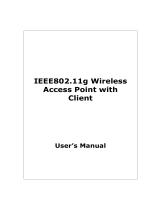2
Table of Contents
1 INTRODUCTION................................................................................................................................5
1.1 F
EATURES
& B
ENEFITS
...........................................................................................................5
1.2 P
ACKAGE
C
ONTENTS
...............................................................................................................6
1.3 W
IRELESS
SOHO R
OUTER
D
ESCRIPTION
................................................................................6
1.4 S
YSTEM
R
EQUIREMENTS
.........................................................................................................7
1.5 A
PPLICATIONS
.........................................................................................................................7
1.6 N
ETWORK
C
ONFIGURATION
....................................................................................................8
a) Ad-hoc (peer-to-peer) Mode..........................................................................................................................8
b) Infrastructure Mode........................................................................................................................................8
2 UNDERSTANDING THE HARDWARE ...........................................................................................9
2.1 H
ARDWARE
I
NSTALLATION
.....................................................................................................9
2.2 IP A
DDRESS
C
ONFIGURATION
.................................................................................................9
3 WEB CONFIGURATION.................................................................................................................10
3.1 L
OGGING
I
N
...........................................................................................................................10
3.2 M
ANAGEMENT
......................................................................................................................11
3.2.1 S
TATUS
.................................................................................................................................12
3.2.2 S
TATISTICS
............................................................................................................................13
3.2.3 D
YNAMIC
DNS .....................................................................................................................13
3.2.4 T
IME
Z
ONE
S
ETTING
.............................................................................................................14
3.2.5 D
ENIAL OF
S
ERVICE
(D
O
S) ...................................................................................................15
3.2.6 L
OG
.......................................................................................................................................16
3.2.7 U
PGRADE
F
IRMWARE
............................................................................................................17
3.2.8 S
AVE
C
ONFIGURATION TO A
F
ILE
..........................................................................................17
3.2.9 R
ESTORE THE
C
ONFIGURATION FROM A
F
ILE
........................................................................18
3.2.10 R
ESTORE
S
ETTINGS TO
F
ACTORY
D
EFAULTS
........................................................................18
3.2.11 A
DMINISTRATOR
S
ETTINGS
...................................................................................................19
3.3 TCP/ IP S
ETTINGS
.................................................................................................................19
3.3.1 LAN S
ETTINGS
– S
TATIC
IP ..................................................................................................20
3.3.2 LAN S
ETTINGS
– DHCP C
LIENT
...........................................................................................21
3.3.3 LAN S
ETTINGS
– DHCP S
ERVER
..........................................................................................22
3.3.4 WAN S
ETTINGS
– S
TATIC
IP.................................................................................................23
3.3.5 WAN S
ETTINGS
– DHCP C
LIENT
.........................................................................................24
3.3.6 WAN S
ETTINGS
– PPP
O
E .....................................................................................................25
3.3.7 WAN S
ETTINGS
– PPTP........................................................................................................26
3.4 W
IRELESS
..............................................................................................................................28
3.4.1 W
IRELESS
B
ASIC
S
ETTINGS
...................................................................................................28
3.4.2 W
IRELESS
A
DVANCED
S
ETTINGS
..........................................................................................29
3.4.3 W
IRELESS
S
ECURITY
.............................................................................................................31
3.4.3.1 W
IRELESS
S
ECURITY
- D
ISABLED
..........................................................................................31
3.4.4 W
IRELESS
S
ECURITY
- WEP..................................................................................................31
3.4.5 W
IRELESS
S
ECURITY
– WPA / WPA2-M
IXED
.......................................................................33
3.4.6 W
IRELESS
A
CCESS
C
ONTROL
................................................................................................34
3.4.7 WDS (W
IRELESS
D
ISTRIBUTION
S
YSTEM
)............................................................................35
3.4.7.1 WDS S
ECURITY
....................................................................................................................36
3.4.7.1.1 WDS S
ECURITY
- N
ONE
........................................................................................................36
3.4.7.1.2 WDS S
ECURITY
– WEP 64/128 ............................................................................................36
3.4.7.1.3 WDS S
ECURITY
– WPA (TKIP), WPA2 (AES) ....................................................................37
3.5 F
IREWALL
.............................................................................................................................39
3.5.1 P
ORT
F
ILTERING
....................................................................................................................39
3.5.2 IP F
ILTERING
.........................................................................................................................40
3.5.3 MAC F
ILTERING
...................................................................................................................41
3.5.4 P
ORT
F
ORWARDING
...............................................................................................................42
3.5.5 URL F
ILTERING
....................................................................................................................43





















